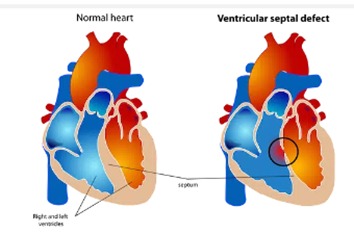VSD
What is a ventricular septal defect?
A ventricular septal defect is a condition where you’re born with a hole in the wall between the two lower chambers of your heart. Often shortened to VSD, this condition is the most common congenital (meaning you have it when you’re born) heart defect and often happens alongside other types of heart problems or defects. A small VSD is usually minor and has few or no symptoms. However, a larger hole may need to be repaired to avoid permanent damage and complications.
What happens inside my heart if I have a ventricular septal defect?
Your heart has four chambers. To pump blood efficiently, the chambers much seal shut. A VSD is a leak that disrupts that efficient pumping ability.
Under normal circumstances, the right ventricle pumps oxygen-poor blood that just arrived from your body out of your heart and into your lungs so the blood can pick up oxygen. The blood then returns to the heart, and its last stop in the heart is the left ventricle, which pumps oxygen-rich blood out to your entire body.
A VSD is a potential problem because it can act as a shunt (a connection) between the heart’s two lower chambers, the left ventricle and the right ventricle. Because the pressure in the left ventricle is higher than the pressure in the right ventricle, oxygen-rich blood mixes with oxygen-poor blood in the right ventricle and then goes to the lungs. That leads to extra blood in the lungs which can cause serious problems.
Who does it affect?
Almost all VSDs are present at birth. A VSD diagnosis most likely happen during childhood, though adults can also receive this diagnosis. However, this only happens in 10% or less of cases. VSD is also slightly more likely to happen in premature babies and babies with certain genetic conditions.
In very rare cases, a heart attack can tear a hole between the ventricles and create a VSD. While this type of VSD — sometimes called ventricular septal rupture (VSR) — is technically a side effect, it is still a dangerous problem that needs to be repaired.
TREATMENT
The two main ways to repair a VSD are:
Surgery : The most reliable way to close a VSD is to patch it surgically. To do this, a cardiac (heart) surgeon will operate and patch or close the hole. Depending on the size and location of the hole, it may be as simple as stitching the hole shut. In other cases, it might involve a patch made of a synthetic material or a graft of your own tissue.
Transcathetor Procedures : Like cardiac catheterization, these procedures use a transcatheter (catheter-based) approach to access the heart via a major artery. Once the catheter device reaches the defect, it can place a specialized device called an occluder and plug the hole. These devices are typically made of a mesh framework covered in a synthetic material.
In either of the above cases, your heart tissue will grow over and around the patch or occlude device. Ultimately, the patch or device should become part of the heart wall between the ventricles.
In cases where an infant or child is under weight or isn’t growing at the expected rate, their healthcare provider may recommend special measures to help them get enough nutrition. This might include a special diet or even a feeding tube.
